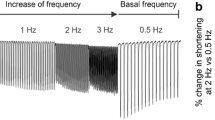Summary
Interventions that augment the contractile state of the heart are associated with, or caused by, alterations in Ca2+ exchange in heart muscles. New inotropic agents have been developed that increase the sensitivity of the myofilaments to Ca2+. To examine the effect of calcium-sensitizing agents on force development, we measured systolic and diastolic intracellular Ca2+ concentration ([Ca2+]i) and constructed [Ca2+]i-force relationships in normal (n=6) and myopathic human hearts (n=10). Using the bioluminescent calcium indicator aequorin, we found that the diastolic [Ca2+]i was 225±52 nM in normal muscles, whereas in myopathic muscles diastolic [Ca2+]i was significantly higher at 361±68 nM. Calcium-sensitizing agents that shift the [Ca2+]i-force relationship toward lower [Ca2+]i increase the diastolic force of myopathic hearts significantly more than in normal human hearts. This leads us to the conclusion that inotropic agents that increase the sensitivity of the myofilaments to Ca2+ further impair relaxation in myopathic hearts, resulting in a reduced contractile reserve and diminished actice force production.
Similar content being viewed by others
References
Baumann G, Ningel K, Permanetter B. Cardiovascular profile of UDCG 115 BS-pimobendane and reversibility of catecholamine subsensitivity in severe congestive heart failure secondary to idiopathic dilated cardiomyopathy. J Cardiovasc Pharmacol 1989;13(5):730–738.
Benedikter L and Mey T. Onset and magnitude of cardiovascular response to dobutamine and AR-L 115, a new positive inotropic agent with additional vasodilating activity in normal subjects. Arzneim Forsch (Drug Res) 1981;31:239–242.
Renard M, Walter M, Liebens I, et al. Pimobendane (UD-CG 115 BS) in chronic congestive heart failure. Short-term and one-month effects of a new inotropic vasodilating agent. Chest 1988;93(6):1159–1164.
Thormann J, Kramer W, Kindler M, et al. Comparative efficacy of the new cardiotonic agent DPI 201–106 versus dobutamine in dilated cardiomyopathy: analysis by serial pressure/volume relations and “on-line” MVO2 assessment. J Cardiovasc Pharmacol 1986;8(4):749–757.
Thormann J, Schlepper M, Kramer W, et al. Effects of AR-L 115 BS (Sulmazol), a new cardiotonic agent, in coronary artery disease: improved ventricular wall motion, increased pump function and abolition of pacing-induced ischemia. J Am Coll Cardiol 1983;2(2):332–337.
Thormann J, Kramer W, Schlepper M. Changes in hemodynamics, coronary flow and myocardial energy metabolism in patients with coronary artery disease after the application of the new cardiotonic agent AR-L 115. Am Heart J 104:1294–1302.
Walter M, Liebens I, Goethals H, et al. Pimobendane (UD-CG 115 BS) in the treatment of severe congestive heart failure. An acute haemodynamic cross-over and double-blind study with two different doses. Br J Clin Pharmacol 1988;25(3):323–329.
Colucci WS, Wright RF, Braunwald E. New positive inotropic agents in the treatment of congestive heart failure: Mechanisms of action and recent clinical development (Parts I & II). N Engl J Med 1986;314:290–299;314:349–358.
Morgan JP. Mechanism of action of inotropic drugs. Heart Dis Update. 1990;136–144.
Lee J and Allen DG. Calcium sensitisers: a new approach to increasing the strength of the heart. Br Med J 1990;300:551–552.
DiBianco R, Shabetai R, Kostuk W, et al. A comparison of oral milrinone, digoxin, and their combination in the treatment of patients with chronic heart failure. N Engl J Med 1989;320:677–683.
Katz AM. Changing strategies in the management of heart failure. J Am Coll Cardiol 1989;13:513–23.
Gwathmey JK, Copelas L, MacKinnon R, et al. Abnormal intracellular calcium handling in myocardium from patients with end-stage heart failure. Circ Res 1987;61:70–76.
Gwathmey JK, Slawsky MT, Briggs GM, et al. The role of intracellular sodium in the regulation of intracellular calcium and contractility: the effects of DPI 201–106 on excitation-contraction in human ventricular myocardium. J Clin Invest 1989;82:1592–1605.
Gwathmey JK and Hajjar RJ. Effect of protein kinase C activation on sarcoplasmic reticulum function and apparent myofibrillar Ca2+ sensitivity in intact and skinned muscles from normal and diseased human myocardium. Circ Res 1990;67:744–752.
Ruegg JC. Effects of new inotropic agents on Ca2+ sensitivity of contractile proteins. Circulation 1986;73 (Suppl III):78–84.
Ruegg JC, Brewer S, Zeugner C, Trayer IP. Peptides from the myosin heavy chain are calcium sensitizers of skinned skeletal muscle fibers. J Muscle Res Cell Motil 1989;10:152–162.
Feldman MD, Copelas L, Gwathmey JK, et al. Deficient production of cyclic AMP: pharmacological evidence of an important cause of contractile dysfunction in patients with end-stage heart failure. Circulation 1987;75(2):331–339.
Gwathmey JK, Slawsky MT, Hajjar RJ, et al. The role of intracellular calcium handling in force-interval relationships of human ventricular myocardium. J Clin Invest 1990;85:1599–1613.
Hajjar RJ, Gwathmey JK, Briggs GM, et al. Differential effect of DPI on the sensitivity of the myofilaments to Ca2+ in intact and skinned trabeculae from control and myopathic human hearts. J Clin Invest 1988;82:1578–1584.
Gwathmey JK and Hajjar RJ. Relation between steady-state force and intracellular [Ca2+] in intact human myocardium. Index of myofibrillar responsiveness to Ca2+. Circulation 1990;82:1266–1276.
Yue DT, Marban E, Wier WG. Relationship between force and intracellular [Ca2+] in tetanized mammalian heart muscle. J Gen Physiol 1986;87:223–242.
Movsesian MA, Bristow MR, Krall J. Ca2+-uptake by cardiac sarcoplasmic reticulum from patients with idiopathic dilated cardiomyopathy. Circ Res 1989;65:1141–1144.
Katz AM. Cardiomyopathy of overload: a major determinant of prognosis in congestive heart failure. N Engl J Med 1990;322:100–110.
Anderson PAW, Oakley A, Allen PD. Human troponin T expression in normal and end-stage heart failure patients. (Abstr) Circulation 1989;80(Suppl II):503.
Kitada Y, Narimatsu A, Matsumara N, Endo M. Contractile proteins: possible targets for the cardiotonic action of MCI-154, a novel cardiotonic agent? Eur J Pharm 1987;134:229–231.
Author information
Authors and Affiliations
Rights and permissions
About this article
Cite this article
Hajjar, R.J., Gwathmey, J.K. Calcium-sensitizing inotropic agents in the treatment of heart failure: A critical view. Cardiovasc Drug Ther 5, 961–965 (1991). https://doi.org/10.1007/BF00143520
Issue Date:
DOI: https://doi.org/10.1007/BF00143520




